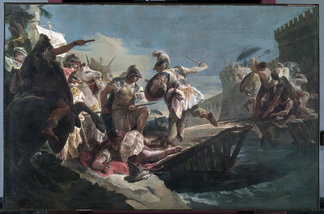While we were busy disclosing deaccessioning at the Pennsylvania Academy of Fine Arts, the Art Institute of Chicago and the Carnegie Museum of Art, the Cleveland Art Museum’s planned sale of 32 works almost slipped by unnoticed.
But on Saturday, the Cleveland Plain-Dealer spilled the beans. Close readers of a Jan. 6 Sotheby’s press release about its Jan. 27 Old Master sale would have been tipped off: it mentions a pair of paintings from the CMA. But I didn’t get that release.
 Once again, I don’t quibble with the sales, as I know them. Steve Litt, who wrote the Plain Dealer article, says the whole shebang, all 32 works, are estimated to fetch just $706,000 to $1,022,000. Small potatoes — so no masterpiece is being sacrificed. Most of the works were gifts (be careful what you accession…) and a couple of others have had their attributions downgraded to lesser artists.
Once again, I don’t quibble with the sales, as I know them. Steve Litt, who wrote the Plain Dealer article, says the whole shebang, all 32 works, are estimated to fetch just $706,000 to $1,022,000. Small potatoes — so no masterpiece is being sacrificed. Most of the works were gifts (be careful what you accession…) and a couple of others have had their attributions downgraded to lesser artists.
For example, we have here a work first thought to be by Giovanni Battista Tiepolo, but downgraded to a follower. It’s expected to raise $200,000 to $300,000.
Another work for sale was ruined by poor conservation.
Further, the plan is to reinvest the proceeds in Old Masters. All good.
This plan to divest some works predates the current director, David Franklin, who took over last September. But it jibes with what he told me recently over coffee: everything the museum buys should be a masterpiece, displacing something already hanging on the walls.
For Cleveland, not really a universal museum, that make sense.
Cleveland also had, and seems to have followed, a real plan, a 12-step process, including:
Jon Seydl, the museum’s curator of European painting and sculpture, sifted through the more than 200 old master paintings in the collection.
The museum also consulted experts in the field, including curators Lawrence Nichols of the Toledo Museum of Art, Edgar Peters Bowron of the Houston Museum of Fine Arts, and professors Edward Olszewski of Case Western Reserve University and Christina Neilson of Oberlin College.
Members of the museum’s education staff were asked whether they could see using any of the potentially salable items in classes.
There’s only one thing wrong with this picture: how we learned about it. Why the museum didn’t get ahead of the story, releasing a press statement of its own, I will never understand.
When something seeps out, it raises suspicions — even ones that are not justified by fact. So why risk it?
UPDATE, 2/2: Here’s another good example of transparency: The Rosenbach Museum and Library reecently decided to deaccession several works by Walter Greaves and possibly one by Whistler, which would go to another museum. It put out a press release on Jan. 17 (here) and the Philadelphia Inquirer wrote about it two days later (here).
After reading my blogs posts on deaccessioning, a press representative for the Rosenbach called both to my attention. Apologies for the delay in updating this post.
